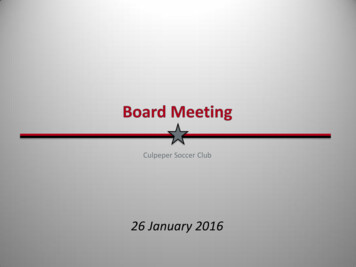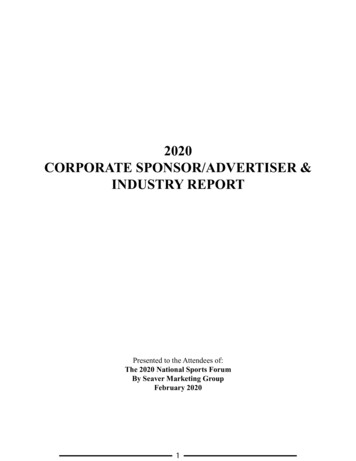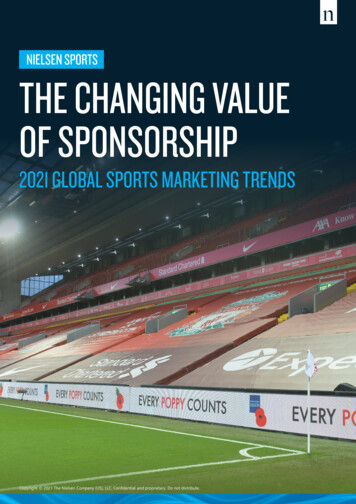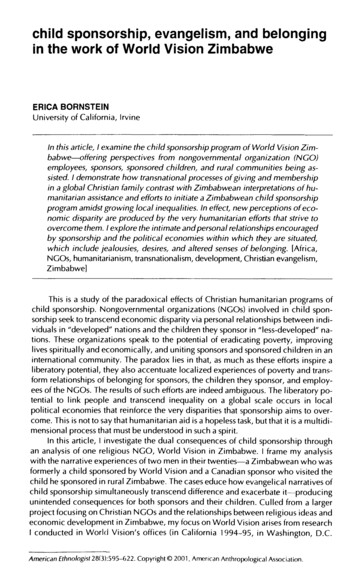
Transcription
1Individual sponsorship implementation and itsmanagerial motivations- A collective case study of the managerial motivations behind theimplementation of individual sponsorship in Swedish outdoor recreationsportsTHESIS WITHIN: Business and AdministrationNUMBER OF CREDITS: 15 ETCSPROGRAMME OF STUDY: Bachelor program International ManagementAUTHORS: Olle Lagerqvist and Daniel CarlssonTUTOR: Nadia ArshadJÖNKÖPING May 2022
2Bachelor thesis in business administrationTitle: Individual sponsorship implementation and its managerial motivations: A collectivecase study of the managerial motivations behind the implementation of individualsponsorship in Swedish outdoor recreation sportsAuthors: Olle Lagerqvist and Daniel CarlssonDate: 2022-05-19Key terms: Sponsorship, sport sponsorship, individual sponsorship, leveraging, congruence,sponsorship-linked marketingAbstractBackground: In recent years, sponsorship has become an important and heavily implementedmarketing communications tool, and the significance of sponsorship is especially seen withinthe context of sports. Despite the heavy implementation of sponsorship, both in a teamcontext and on an individual level, existing sponsorship literature has been strongly focusedon sponsorship in a team context, thus neglecting the individual aspect of sponsorship.Furthermore, previous literature has highlighted the importance of implementing clearobjectives into the overall strategic marketing plan to respond to difficulties in tracing andevaluating sponsorship. The lack of existing literature on individual sponsorship and the needfor clear objectives raises questions about managerial motivations behind the implementationof sponsorship.Purpose: The purpose of this study is to investigate the underlying managerial motivationsbehind the implementation of individual sponsorship in outdoor recreation businesses inSweden. In doing so, this study aims to reduce existing literature gaps within sponsorship.Method: A qualitative collective case study with an abductive approach was conductedutilizing semi- structured interviews with 5 relevant participants who are working in outdoorrecreation brands within the Swedish market.Conclusion: Findings of this study revealed that building credibility through the use ofindividual sponsorship was found to be a highly desired outcome, and strong motivationbehind implementation. By transferring meaning, such as credibility, from well known andtrusted athletes to the brand through associations, the brand in question wished to achieve
3increased strength of communicated brand messages. The development and strengthening ofthe brand community was identified as another key motivation behind individual sponsorship.Through the use of individual athletes' mix of properties such as performance, social ability,and own network was believed to strengthen brand community. Another finding was themotivation to achieve brand awareness-through high media exposure using leveraging as atool. Lastly, the research found that except for implementing sponsored athletes in themarketing activities, utilizing the athletes in the product development process was themotivation behind implementation of individual sponsorship.
4AcknowledgementsFirstly, the authors of this study would like to express our gratefulness to all participants inthe interviews for taking their time and sharing valuable information with us. We highlyvalue and cherish the insights everyone of you have shared. Thank you for your participationand contribution of different thoughts and perspectives that furnished the foundation for thisthesis. It would not have been possible without you.Secondly, the authors would like to thank our tutor Nadia Arshad and course coordinatorAnders Melander, for helping us throughout the thesis process with their knowledge andguidance.Lastly, the authors also want to express their gratitude towards the other thesis groups forproviding us with helpful feedback and valuable thoughts during seminars and tough times.Many thanks!
5Table of ContentsIntroduction1.1 Background1.2 Problem discussion1.3 Purpose1.4 Research Question1.5 Delimitations1.6 Definitions779101111112.0 Frame of reference2.1 Sponsorship2.1.1 Sports Sponsorship2.1.2 Individual Sponsorship2.2 Antecedents of Sponsorship2.2.1 Leveraging2.2.2 Low level processing & Mere exposure2.2.3 Sponsor-sponsee fit (congruence)2.2.4 Identification - social identity2.3 Celebrity Endorsement2.4 McCracken’s meaning transfer model2.5 Source credibility model1212131314141516171818213.0 Method & Methodology3.1 Methodology3.1.1 Research paradigm3.1.2 Research design3.1.3 Research approach3.2 Method3.2.1 Method of Data collection3.2.2 Semi-structured interviews3.2.3 Question design and formulation3.2.4 Sampling Approach3.2.5 Selected Sample3.2.6 Secondary data3.2.7 Data analysis and coding structure3.3 Ethical considerations and trustworthiness3.3.1 Credibility3.3.2 Transferability3.3.3 Dependability3.3.4 Confirmability232323232425252526262728293031323233
64.0 Empirical findings4.1 Credibility - The quality of being trusted and believed in.4.1.1 Trustworthiness4.1.2 Verifying Quality4.1.3 Communicating values4.2 Community4.2.1 Relationships4.1.2 Network4.1.3 Identification4.2.4 Storytelling4.2.5 Long-term commitment4.3 Awareness - the knowledge of existence4.3.1 Exposure4.3.2 Leveraging4.4 Product Development4.4.1 Product Development333535363839394041414243434445455.0 Analysis5.2 Credibility5.2 Community5.3 Awareness5.4 Product Development47475153556.0 Conclusion567.0 Discussion7.1 Contributions7.2 Limitations7.3 Implications7.4 Future Research58585859598.0 References619.0 Appendix9.1 Interview guide6767
71. IntroductionIn this section, the reader is introduced to key concepts through background, problemdiscussion, and purpose. The research question is presented as well as a description of definitions usedthroughout this study along with delimitations of the study.1.1 BackgroundIn 1984 a struggling sports brand called Nike signed a 500.000 sponsorship deal with a 21year-old rising basketball star by the name of Michael Jordan, the rest is history. Within thefirst year of its launch, the “Air Jordan” shoe generated a whopping 126 million in sales andlaunched the Nike brand to the top of the athletic shoe manufacturing world (Pawar, 2020).The collaboration between Nike and Michael Jordan is perhaps the most famouscollaboration in sports and showcases the immense power of individual sponsorship. Despitethe extensive nature of existing sponsorship literature and the widely accepted ability ofindividual sponsorship to transfer positive feelings from athlete to brand through associations(Cornwell et al., 2001), the existing literature has neglected the individual aspects ofsponsorship (Reams et al., 2015)Historically, traditional advertising in television, radio, and print has been seen as theundisputed marketing champion. However, during the 1980s and ’90s, the concept ofsponsorship and sponsorship-linked marketing as a marketing communications tool startedgaining significant traction (Cornwell & Maignan, 1998). Sponsorship has since then becomean established and highly important component of brand strategy and thus also of themarketing mix of businesses worldwide (Cornwell & Kwon, 2020). The sponsorship ofsports, organizations, events, and additional marketing spending related to these causes nowmake up a significant share of the total advertising spending of many firms.According to The International Events Group (IEG) Sponsorship Report (2018), the globalsponsorship spending has increased by 52% between the years 2008-2018, increasing from43,1 billion USD to 65,8 billion USD and is expected to continue on the same trajectory.Sponsorship covers several areas, but the most prolific sector is within sports. Gough (n.d),claim that the sports sponsorship market in 2020 was worth 57 billion dollars globally thustaking up a majority of global sponsorship expenditures. This market is also estimated to
8reach 97 billion dollars by 2027; this indication shows how valuable sponsorship is forbusinesses, especially in the sports segment. Despite the overwhelming implementation ofindividual sports sponsorship world wide, the research on the underlying managerialmotivations behind this implementation is still underdeveloped (Reams et al, 2015).Cornwell (2020) pointed out difficulties in tracing and evaluating sponsorship objectives tooutcomes and therefore highlights the importance of implementing focused objectives in theoverall strategic plan. Meenaghan (2013) further highlights a lack of sufficient evaluationmethods of sponsorship which has given rise to a significant demand for improved methodsof evaluating returns on sponsorship investments. The combination of lack of viableevaluation methods, the importance of focused objectives and the underdeveloped state ofindividual sponsorship literature raises questions about the driving motivations behindindividual sponsorship implementation. Therefore, this study aims to explore the underlyingmanagerial motivations behind implementation to identify the driving forces behindimplementation. To be able to research these aspects of individual sponsorship, the authors ofthis study found the Swedish outdoor recreation market to be suitable for investigation due tothe high usage of individual sponsorship within this sector.
91.2 Problem discussionDuring recent decades sponsorship as a marketing communications tool has gainedsignificant traction within the marketing world. The concept of sponsorship has many areasof application, however sports sponsorship has become the most prominent area ofapplication (Tsordia et al., 2018). With increasing spending associated with sponsorship andsponsorship-linked marketing there has also been a growing demand for research that cancontribute to the understanding and application of sponsorship, and linked activities.Existing literature on the topic of sponsorship is extensive but lacks cohesion. Cornwell &Kwon (2019) conducted a systematic review of sponsorship-linked marketing researchranging from 1996 to 2017 in an effort to analyze the state of current research on the topic.This study highlighted the fact that sponsorship research is, in its current state, fragmentedacross several disciplines and is therefore disconnected. Furthermore, the study concluded anexcess of audience response research while the marketing management process ofsponsorship was deemed underdeveloped.Current literature on the topic of sponsorship is conducted with a strong focus on sponsorshiprelated to organizations and events. However, there is a lack of in-depth exploration of theindividual aspect of the sponsorship. While a number of studies have researched how sportssponsorship impacts brand equity (Cornwell et al., 2001; Grohs, Wanger, & Vsetecka, 2004;Henseler, Wilson, Gotz, & Hautvast, 2007; Smith, 2004) based on Aaker’s (1991) brandequity model, these have all investigated team and organizational sponsorship, thusneglecting individual sponsorship. Reams et al (2015) state that existing literature is centeredaround sports sponsorship in a “team” context, and further underlines the need for academiccoverage of individual sports where athletes operate independently without a team and/ororganizational context. This gap in literature presents further research opportunities withinthe area of sponsorship.The inherent risk associated with sponsorship activities is higher than what would beexpected in a more traditional advertising context. In advertising, the corporation has fullcontrol over all of its communications and is therefore in full control of its own brand equity.In a sponsorship context, some of this control is surrendered to the sponsored entity as theactions of said entity are associated with the brand of the sponsor (Cornwell, 2020). Thisinherent risk is even greater with individual sponsorships as the actions of single individuals
10generate a more concentrated influence on the sponsor's brand. Therefore, this type ofrelationship must also be more closely monitored and managed (Cornwell, 2020). Despite theincreased risk associated with individual sponsorship, it is still a highly utilized form ofsponsorship. The increased risk associated with sponsorship, and in particular individualsponsorship, opens up opportunities for further investigation of the managerial motivationsbehind the implementation of sponsorship despite risks.In conclusion, as we lack in-depth exploration of the individual aspects of sponsorship weaim to explore the motivations behind the implementation of individual sponsorship. Bydoing so, this study aims to contribute to widening existing knowledge of individualsponsorship in a brand-building context.1.3 PurposeThe authors of this study found a significant discrepancy in the level of literaturedevelopment between sponsorship in an organizational/team context and sponsorship in anindividual context. This opens up possibilities for further further research with the aim ofincreasing understanding of sponsorship implementation in an individual context.Furthermore, despite a lack of viable measurements of brand value generation, andheightened risks associated with individual sponsorship there has been a heavy increase in theimplementation and spending of sponsorship. This raises questions about the motives behindimplementation of individual sponsorship and presents a gap in existing literature.Additionally, in order to evaluate outcomes, one must first understand the motivations behindimplementation. Therefore, the purpose of this study is to investigate the underlyingmanagerial motivations behind the implementation of individual sponsorship at outdoorrecreation businesses in Sweden. By doing so, the authors of this study aims to contribute toan underdeveloped section of sponsorship litterature.
111.4 Research QuestionTo meet the purpose of this study, this is the research question under study (RQ):RQ: Why do Swedish outdoor recreation companies use individual athlete sponsorship?1.5 DelimitationsAfter evaluating the topic, the scope of the study was narrowed on several points tocorrespond to the time and resource constraints of this study. The outdoor recreation sectorwas deemed suitable for this study due to its high implementation of individual sponsorship.Additionally, the geographical scope was limited to the Swedish market. By doing so, theresearchers limited potential cultural and geographical differences within the sample allowingfor the data to be compared more objectively, furthermore this was also more realistic interms of resources available for this study. The research focuses on drivers behindimplementation of sponsorship and therefore neglects actual outcomes of the sponsorships.This decision was made as the researchers felt that the time and resource constraints, incombination with a lack of previous research experience would not allow for inclusion ofoutcomes to be performed in a satisfactory manner. Additionally, this study focuses onindividual sponsorship through the lens of the sponsors, thus neglecting the consumersperceptions.1.6 DefinitionsOutdoor recreation - Outdoor recreation activities or sports include snow sports,watersports, camping, fishing, hunting, motorcycle riding, off-roading, trail, and bicycling(Outdoor Industry Association).Sponsorship - The International Events Group (IEG, 2000), defines sponsorship as a cashand/or in-kind fee paid to a property (typically a sports, entertainment, non-profit event, ororganization) in return for access to the exploitable commercial potential associated with thatproperty
122.0 Frame of referenceThe frame of reference section aims to introduce the reader to an overview of literature and theory relevant foranswering the research question of this study.2.1 SponsorshipWhen reviewing the literature on the topic of sponsorship it is apparent that the occurrence ofsponsorship as a marketing communications tool has become increasingly prevailing withinthe marketing mix of businesses. Furthermore, the sponsorship of sports, events,organizations and various causes has been recognized as useful in building brand awarenessand image as well as contributing to corporate image (Cornwell, Roy & Steinhard, 2001).These elements are integral parts of brand equity and highlight the usefulness of sponsorshipas a brand-building tool (Keller, 1993; Aaker 1996). Raising awareness, heightening brandimage, and attitudes towards sponsors are some of the more well-researched areas withinsponsorship, and the ability of sponsorship to influence these has been well established(Becker-Olsen & Hill, 2006; Bennett, 1999; Meenaghan, 1991; Nufer & Buehler, 2010;Rines, 2002; Roy & Cornwell, 2003).As generating brand awareness and corporate image are seen as naturally accruing or moreeasily obtained aspects of sponsorship these can be categorized as “general brand equityelements”. Where the generation of awareness and corporate image are seen as general, thetransmittance of brand personality, differentiation from competitors as well as thedevelopment of an image of quality and brand loyalty are categorized as “distinctive brandequity elements”. The general brand equity elements are more easily obtained, whiledistinctive elements require greater involvement, and commitment from a managerial level(Cornwell et al., 2001). Therefore, in a hierarchy of effects context, Cornwell et al. argue thatsponsorship holds the most value at the early stages of awareness development. Furthermore,sponsorship has proven to be a highly efficient method for differentiating your brand from thecompetition. Cornwell et al. (2001, 2005) claim that the differentiation from competitionthrough the development of distinctive brand equity elements can prevent imitation andgenerate competitive advantages which, in extension, can be translated to a boost in thefinancial value of a brand.
132.1.1 Sports SponsorshipSponsorship is found in a wide array of areas, but the most popular and prominent field ofsponsorship application is found in sports. Global sponsorship spending in 2018 wasestimated at 65,8 billion USD. In 2020, despite the global covid-19 pandemic, the globalsports sponsorship amounted to an estimated 57 billion USD (Gough, n.d). The phenomenonof sponsorship within sports has the same underlying mechanisms as other areas ofsponsorship and can offer an opportunity to gain exposure to new audiences as well asincrease brand awareness and corporate brand image (Tsordia et al., 2018). Tsordias et al.also state that brand associations are a motivating factor for sportsponsorship spending.Companies who invest in sports sponsorship do so with the belief that positive feelingstowards a team/individual athlete will be transferred to their brand through association.Given the loyal and passionate nature of sports fans, the customer perception and thoughtsare of particular interest in a sports context. Furthermore, sports fans are highly likely topartake in continuous and prolonged interaction with the sports brand or individual (Tsordiaet al., 2018). Cornwell et al. (2001) investigated the importance of duration in sportssponsorship and its effect on brand equity. In this study, they present data that suggests thatthe duration of the sponsorship does play a role in the sponsorship's impact on brand equity.By building a lasting successful sponsorship relationship with an organization or individualwe prolong the consumers exposure to our brand, can generate greater brand engagement,and hopefully in the end transfer loyalty from the sponsored entity to our brand. Keller (2001)states that brand engagement is perhaps the greatest predictor of brand loyalty thus furtherhighlighting the importance of brand engagement within sports and sponsorship as a whole.2.1.2 Individual SponsorshipAn overwhelming part of today's sporting events and organizations are involved insponsorships. As sponsorship spending increases yearly there is also a growing demand forresearch that heightens understanding of the mechanisms of sponsorship and how this affectstheir investments (Alonso-Dos-Santos et al., 2016).According to Cornwell (2020) the sponsorship of individuals can be utilized as a “standalone” strategy or as a measure of adding theme or creativity to a sponsorship event or
14activity. Cornwell also implies the underlying risk/reward with incorporating individuals toyour sponsorship strategy. Integration of individual sponsorship may give your marketingstrategy a different tone. As people tend to connect, follow and mimic the behaviors ofindividuals, individual sponsorship has the ability to generate strong brand engagement,associations and attitudes. However, an individual may also be despised and disregarded fortheir behavior, both professional and individual. Individual sponsorship allows for aconcentrated influence on the sponsor brand, both positive and negative. As the actions ofstand-alone athletes generate a more concentrated influence on the sponsorship brand, it mustalso be managed more closely to minimize risk (Cornwell, 2020). The understanding of risksassociated with sponsorship opens up questions as to the motivations for implementingsponsorship on a corporate level despite the heightened risk.2.2 Antecedents of Sponsorship2.2.1 LeveragingLeveraging is described as all additional sponsorship-linked spending, outside of theadditional sponsorship fee, in forms of marketing like advertising, social and digital media,technology, and hospitality. Investing in sponsorship is one thing; leveraging means alladditional marketing investments to increase brand awareness using the property after theinitial investment (Cornwell, 2020). Cornwell (1995, p. 15) defines sponsorship-linkedmarketing as "the orchestration and implementation of marketing activities for the purpose ofbuilding and communicating an association to a sponsorship." This notion of orchestrationaccentuates that the communication goals of sponsorships are realized only throughthoughtful management and considerable leverage of the sponsorship investment (Cornwell,1995)Sponsorship has evolved rapidly over recent decades. It has formed a situation in whichorganizations must select broader and additional integrated methods to fully profit from theirsponsorship investment (Donlan & Crowther, 2014). Sponsorship is an acquisition thatallows a sponsor to associate itself with a property. In terms of sponsorship-linked marketing,what potential does the purchased access provide the sponsors when a deal is made? This iswhere leveraging takes part.
15According to Keller (2013), the leveraging process is about creating new brand associations.Connecting the brand to some other matter like a person, organization, or place may completea renewed collection of associations and affect existing brand relationships. Having aconnection between a brand and another entity, customers may form brand judgments,feelings, and associations linked to that entity. Leverage is vital to successful sponsorshiplinked communication since a management's creative use of leverage will help differentiatesponsorship related to their brand (Cornwell, Roy, and Steinard 2001). The authors furthersuggest that the more sponsors leverage their endorsements, they will achieve higher levels ofbrand differentiation and the greater brand's financial value.2.2.2 Low level processing & Mere exposureDuring the 1980’s and 90’s, literature on effective-based preference started emerging. Thisresearch concluded that cognitive processing might not be necessary for the subject to formaffective preferences (Zanjoc & Markus,1982; Janiszewski, 1993). The mere-exposurehypothesis presented by Zanjonc (1968,1980) suggests that re-occurring exposure to astimulus will provoke an effective response. In this case, preference and liking are evokedwithout awareness of the preference-formation-process. This response to repeated exposurehas been identified over a range of stimuli, including; words, pictures, and figures (Cornwellet al., 2005; Bornstein, 1989).In addition to the lack of conscious processing, studies have found that the subject will createpreference even in the absence of exposure memory (Bonanno & Stillings, 1986; Bornstein &D’Agostino, 1992; Janiszweski, 1993; Vanhuele, 1995; Zajonc & Markus, 1982). It is alsoworth noting that while previous research has found involvement to be an unnecessary factorfor activating the mere-exposure effect, it has been shown to provide an importantmoderating effect on the cognitive processing models (Petty et al., 1983; Vakratsas andAmbler, 1999). Olson and Thjømøe (2003) conducted a study where mere exposure wascontrasted to central and peripheral processing. Petty, Cacioppo, and Schumann (1983)referred to central-route processing as high-involvement situations requiring thoroughconsideration, which results in the formation of brand attitude or change of said attitudes. Incontrast to central-route processing, Petty et al. (1983) refer to peripheral processing as lowinvolvement decisions that influence outcomes in brand attitudes.
16The Petty et al. (1983) study found further support for the ability of mere exposure to formfavorable brand attitudes based solely on exposure to the brand. Furthermore, the studyindicated that individuals who processed additional brand information showed a heightenedpreference compared to those exposed to additional brand information yet did not process theinformation. Cornwell et al. (2005) state that while mere-exposure effects are highly relevantin a sponsorship context and can be influential in the individuals' prior experience with thebrand, it is most likely low-level processing and reactivation of prior brand associations thathold the greatest applicational potential within the context of sponsorship communication.An example of low-level processing applicability within a sports-sponsorship context is theCornwell et al. (2000) study which showed exposure to sponsor messages in a sports-arenasetting will influence recall for sponsors.2.2.3 Sponsor-sponsee fit (congruence)Congruence theory is an essential element in the world of sponsorship; it is also known asmatch or similarity fit (Cornwell, 2014). According to Gwinner (1997), congruence is amoderating factor to strengthen a corporate brand image when a business is sponsoring anevent. When there is a similarity between a sponsor and sponsee, the individual's processingof the sponsorship is improved. This concept implies that relatedness or similarity influencesmemory storage, attitudes, and information retrieval. Gwinner (1997) classes similarity intotwo categories: functional and image-related similarity. The functional similarity means thatthe participants of an event are using a sponsored product. For example, a cross-country skievent sponsored by a ski brand is fitting and easy to remember. The image-related similarityis explained as when the values of a sponsor match the sponsee's image.Speed & Thompson (2000) have listed a five-item scale used to measure the effect ofconsumers' perception of the fit between a sponsor and an event and attitudes towards thesports event. The scale included:1. There is a logical connection between the event and the sponsor.2. The image of the event and the image of the sponsor are similar.3. The sponsor and the event fit together well.4. The company and the event stand for similar things.
175. It makes sense to me that this company sponsors this event.The result of their research suggested that the critical characteristics ofdeveloping a higher positive outcome from the endorsement comes fromsimilarity-fit, perceived sponsor's presence, and genuineness (Speed and Thompson, 2000).In the case of a sponsored individual, congruence is an important factor when choosing theright person to endorse. Therefore, a successful endorsement of an individual will bedependent on the pairing of the person and the sponsor. Dees, Bennett, & Ferreira (2010)researched the outcome of personality fit between sponsee and sponsor regarding brand andpurchase intentions. Their study found that a higher degree of personality fit between the twogenerated more positive consumer attitudes towards the main driver sponsor.2.2.4 Identification - social identitySocial identity is when individuals have a sense of who they are based on their groupmembership. More explicitly, groups are, for example, social class, family, or a sports teamwith which people have a strong connection. These memberships are an important source ofpridefulness and dignity since they represent identity and a feeling of belonging to the socialworld (Tajfel, 1979). Existing literature and research point out that social identity, in otherwords, identification, is when individuals systematically define themselves from others bymaking social classifications (Cornwell, Roy, and Weeks, 2005).(Swansson & Davis, 2006) suggest that organizational identification, a cognitive connectionwhen workers' self-concept has the same attributes as the perceived organization's identity,can be drawn to identification within customers and sports fans. The willingness ofindividuals engaged in buying behavior towards a business is predicted to be associated withgreater identification (Swansson & Davis, 2006).Mardigal (2000) researched how the influence of social identity and alliance connections withsports teams resulted in the purchase intentions of the team sponsors' products. Fans withhigher identification levels with a sponsee will aspire to corporate sponsors. Results of theresearch showed promising buying preferences were related to team identification. Mardigal(2000) suggests that corporate sponsors who can align themselves successfully into a
18customer's identification with the sponsee will capture the customer's share of heart—being
Key terms: Sponsorship, sport sponsorship, individual sponsorship, leveraging, congruence, sponsorship-linked marketing Abstract Background: In recent years, sponsorship has become an important and heavily implemented marketing communications tool, and the significance of sponsorship is especially seen within the context of sports.










